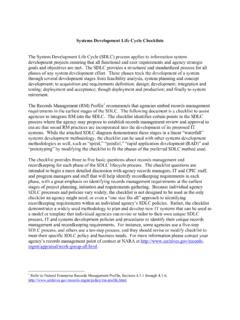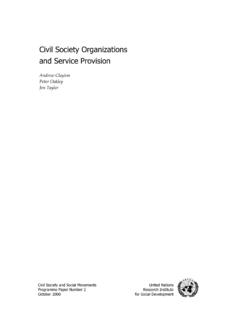Transcription of How the West Was Settled - National Archives
1 How the West Was SettledThe 150-Year-Old Homestead Act Lured AmericansLooking for a New Life and New OpportunitiesBy Greg BradsherWhen the war for American independence formally ended in 1783, the United States covered more than 512 million acres of land. By 1860, the nation had acquired more than billion more acres, much of it in the public domain. How to dispose of the public land was a question that Congress addressed almost continuously. At the nation s beginning, the land was seen primarily as a source of revenue to reduce the National debt, and most land laws adopted before the Civil War provided for the sale of public lands, after 1820, at $ an the 1820s through the 1840s, westerners pushed for more liberal land laws, calling for free homesteads or donations for those who would settle on the land.
2 During the 1840s, the call for homestead legislation received sup-port from eastern labor reformers, who envisioned free land as a means by which industrial workers could escape low wages and deplorable working did, on occasion, offer free land in regions the nation wanted Settled . But the landmark law that governed how public land was distributed and Settled for over 100 years came in 1862. The Homestead Act, which became law on May 20, 1862, was responsible for helping settle much of the American West.
3 In its centennial year in 1962, President John F. Kennedy called the act the single greatest stimulus to National de-velopment ever enacted. This past year marked the 150th anniversary of the Homestead provisions of the Homestead Act, while not perfect and often fraudulently manipulated, were responsible for helping settle much of the American West. In all, between 1862 and 1976, well over 270 million acres (10 percent of the area of the United States) were claimed and Settled under the Laws BredConfusion for Settlers Pre Homestead Act legislation included the Armed Occupation Law of 1842, which offered 160 acres to each person willing to fight the Indian insurgence in Florida and occupy and cultivate the land for five years.
4 Between 1850 and 1853, Congress offered 320 acres to single men and 640 acres to couples settling in the Oregon Country. A similar, but less generous proposition was extended in 1854 to include the New Mexico Territory. During the 1850s, the demand for free land increased. The Republican Party s 1860 presidential platform called for passage of a homestead measure. President-elect Abraham Lincoln on February 12, 1861, said he thought a Homestead Act was worthy of consideration so that the wild lands of the coun-try should be distributed so that every man should have the means and opportunity of benefiting his condition.
5 In the decades before passage of the Homestead Act, there was opposition to giving away the public domain. After the Mexican War added vast areas of land in the West, southern slaveholders worried that opening the un-developed territories to small, independent farmers op-posed to slavery would upset the delicate political balance between the slave and free states in the Senate. Others voiced fear that the offer of free land would spur immigration from Europe. But the proponents of an act achieved success with An Act to Secure Homesteads to Actual Settlers on the Public Domain in that time, a billion acres of government land (much of it mountain and desert unfit for agriculture) were avail-able for homesteading.
6 Under the act, any citizen (or per-son who intended to become one) who was the head of a family, or a single person over 21, who had never taken up arms against the government could apply for a quarter-section of land 160 acres. Potential homesteaders included women who were single, widowed, or divorced or deserted by their husbands. Eventually, under certain situ-ations, some married women could file homestead claims on land adjacent to their husband s homesteaded land had to have been surveyed and be in one of the 30 public domain states.
7 All states were public domain states except the 13 original states, and Kentucky, Maine, Vermont, West Virginia, Tennessee, Texas, and eventually were, however, strict rules for those who got one of the parcels. The prospective homesteader paid a filing fee of 10 dollars to claim the land temporarily. Then he made a small payment to the land office representative. He had six months to begin living on the property. He Opposite: Farmers with their combine in Washington State, ca.
8 1900. The Homestead Act of 1862 and later acts were responsible for help-ing settle the American West. This past year marked the 150th an-niversary of the act. Opposite, background: This poster advertised land for sale for 6 per ct Interest and Low Prices, in Iowa and Nebraska in 1872. In the post Civil War years, settlers moved westward into the Great Plains following the expansion of the 27 How the West Was Settledcould commute his claim before the end of five years to a cash entry, $ per acre, as long he had lived on the property for six government would issue a patent (deed) for the land after five years of con-tinuous residence.
9 But during that period, the homesteader had to build a dwelling and cultivate some portion of the land. No speci-fied amount of cultivation or improvements was required, but there had to be enough continuous improvement and actual cultiva-tion to demonstrate good the five-year period, the home-steader could not be absent for more than six months a year, nor could he establish legal residence anywhere else. A leave of ab-sence for one year or less could be granted when total or partial failure or destruction of crops, sickness, or other unavoidable casual-ty prevented a homesteader from supporting himself and his family.
10 After publishing his intent to close on the property and paying a six-dollar fee, the homesteader received the patent for the Slow, Early StartPicks Up SteamThe Homestead Act was often amended. The first amendment came in 1864, when a person serving in the military was allowed to make a homestead entry (appli-cation) if some member of his family was residing on the lands. In January 1867, Congress allowed Confederate veterans to take homesteads if they signed an affidavit of allegiance to the 1872 amendment permitted veterans to receive credit for their period of service in determining the time required for residence in perfecting a homestead entry.











